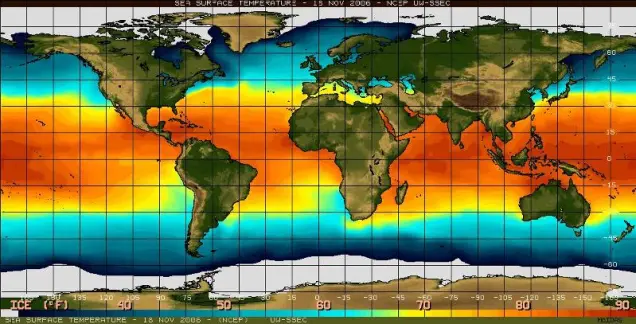Climate

Climate is the common pattern of weather that happens in an area. It includes the temperature, humidity, and precipitation that occurs in an area over an extended period of time. When someone says, “Climate Change”, they mean that these three factors are changing over time.
The sun is the biggest contributor to the climate of an area because the temperature in that zone can change the humidity or precipitation, but the ocean is also a big factor in determining the climate.

This is a picture showing the surface temperature of the ocean. As you can see, the ocean is the warmest around the Equator because the Earth is tilted and most sunlight hits the Equator.
Because of the Earth's tilt, heat is spread unevenly across the globe. Most is at the middle, where it can get to 36˚C (in the water), and the least is at the ends, where it can get to -2˚C. Overall, the average temperature of the ocean surface is 17˚Celsius. HOWEVER, that is just the surface temperature.

A thermocline is a zone in the ocean where the temperature changes rapidly with depth. The thermocline makes a boundary between the shallower, warmer zones, and the deeper, colder ones.
This boundary usually begins at 100-400 meters below the surface of the water and extends several meters downward. 90% of the ocean's water is below the thermocline, and most of it is between 0-3˚C
The ocean also contributes to world climate by influencing the water found in the atmosphere. From the oceans comes most of the water vapor that falls as rain or snow. Winds blowing in from the sea typically contain more water vapor and make coastal areas more humid.
The ocean and the atmosphere affect each other drastically. For instance, if the weather changes and it becomes colder, clouds form, blocking the sunlight from warming the ocean, which in turn has an effect on the ocean current.




